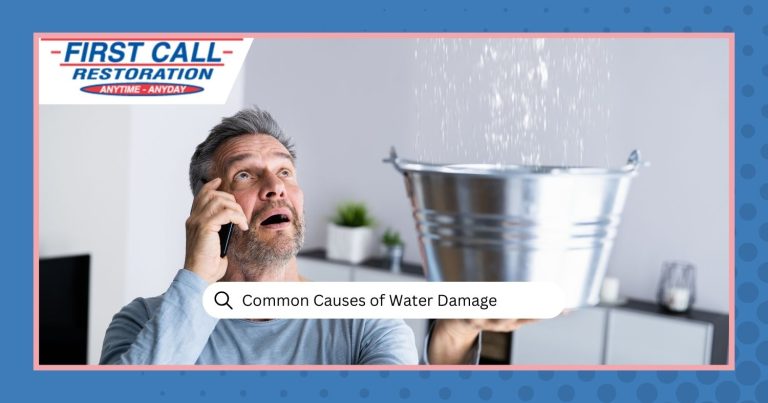Table of Contents
ToggleWater damage is a common issue that homeowners face, but recognizing the signs early can save you from costly repairs and extensive damage. We will guide you on how to identify the signs of water damage and offer practical tips for preventing it. It is important to know that services such as water damage restoration Hudson can help you recognize the signs and tackle the issue.
What is Water Damage?
Water damage happens when water intrudes into areas where it shouldn’t be. This can happen due to burst pipes, leaking roofs, overflowing sinks, or natural disasters. Recognizing and tackling water damage quickly can prevent extensive damage and health risks. The Federal Emergency Management Agency (FEMA) supports water damage restoration and recovery efforts. They provide resources and guidelines to help homeowners manage water damage and recover from its effects. Knowing FEMA’s role can be beneficial in severe water damage situations.
Early Signs of Water Damage
How to tell if you have water damage? Early signs of water damage can be subtle but are easy to spot if you know what to look for. Identifying these signs early can save you from costly repairs and extensive damage. Here are some key indicators to watch out for:
- Discoloration on Walls or Ceilings: What does water damage look like on walls and ceilings? Water damage often causes dark or yellowish stains on walls or ceilings. These stains can appear as small spots or large patches, indicating moisture accumulation behind the surface.
- Musty Odors: A musty smell is often a sign of mold, which grows in damp environments. If you notice an unusual odor, especially in areas prone to moisture like basements or bathrooms, it could indicate water damage.
- Water Stains or Spots: Water stains are another common sign of water damage. These can appear on walls, ceilings, or floors, and often indicate a leak or moisture problem.
- Soft or Sagging Spots on Floors and Ceilings: If certain areas of your floors or ceilings feel soft, spongy, or are sagging, it could mean that water has weakened the structural integrity of these areas.
Preventing Water Damage
Preventing water damage is much easier and less expensive than repairing it. Regular inspections and proper maintenance can help you avoid many common water damage issues.
Regular Inspections
Regular inspections are important for preventing water damage. By routinely checking your home, you can catch potential problems early before they escalate. Here are some areas to focus on during your inspections:
- Roof: Inspect your roof for missing or damaged shingles, leaks, and signs of wear. Pay special attention to areas around chimneys, vents, and skylights, as these can be common spots for leaks.
- Basement: Check your basement for any signs of moisture, mold, or water intrusion. Look for cracks in the foundation and make sure your sump pump is functioning correctly if you have one.
- Plumbing System: Regularly inspect your plumbing system for leaks, corrosion, or damage. Check under sinks, around toilets, and near water heaters for any signs of moisture or leaks.
- Exterior: Examine the exterior of your home for any cracks or gaps in the siding, foundation, or around windows and doors. Seal any openings to prevent water from entering your home.
Maintenance Tips
Proper maintenance is key to preventing water damage. Here are some maintenance tips:
- Drainage System Maintenance: Keep your drainage system clear to prevent water buildup. Make sure that gutters and downspouts are free of debris and direct water away from your home’s foundation. Consider installing a French drain or sump pump if you have persistent water issues around your home.
- Humidity Control: Use a dehumidifier in damp areas, such as basements and bathrooms, to reduce humidity levels. This can help prevent mold growth and other moisture-related issues.
- Window and Door Maintenance: Check the seals around windows and doors for any gaps or damage. Recaulk or replace seals as needed to prevent water from entering your home. Ensure that windows and doors close tightly and are in good condition.
- Appliance Maintenance: Regularly inspect and maintain household appliances that use water, such as washing machines, dishwashers, and refrigerators. Check hoses and connections for signs of wear and replace them if necessary. Clean appliance filters and ensure proper drainage.
Identifying Hidden Water Damage
Hidden water damage can be tricky to spot but can cause significant issues if left unhandled. It often lurks behind the scenes in areas like behind appliances, under sinks, and inside walls where moisture can accumulate unnoticed. To identify hidden water damage, it is necessary to use the right tools and techniques. One of the most useful tools for this purpose is a moisture meter. Moisture meters measure the moisture content in materials such as wood, drywall, and concrete.
Cost Implications
Delaying repairs can lead to more extensive and expensive fixes. Tackling water damage early is often less costly than repairing significant damage later. Regular maintenance and quick repairs with the help of local experts can save you money in the long run.
Contact First Call Restoration for Successful Water Damage Solutions
If you suspect water damage in your home, don’t wait until it’s too late. Early detection and quick action can save you from costly repairs and extensive damage. Trust the experts at First Call Restoration to provide detailed water damage solutions. Our experienced team uses advanced tools and techniques to identify and tackle water damage quickly and successfully. Call us today at (845) 442-6714 or fill out an online form on our website.




